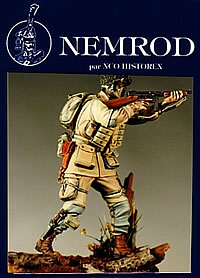| Pathfinder,
Normandy, June 1944 |
 |
 Nemrod N35041 This is an excellent figure of a well-equipped paratrooper advancing with his Thompson M1 submachine gun. Some vendors, such as Squadron, label this as a "Pathfinder 101st Division Airborne 506 PIR" (Parachute Infantry Regiment) but the figure can represent either the 101st or 82nd Airborne divisions that dropped into Normandy on June 6, 1944. (Note: If you apply insignia to these figures, either from Hudson & Allen or Archer Fine Transfers, do not apply an American flag to any figure representing the 101st Airborne in Normandy. While it's shown on the DML U.S. Army Airborne set for Normandy, Ron Volstad stated in 2001 that he made a mistake in his artwork and subsquent research has failed to yield any photos of 101st paratroopers with flags sewn on their right sleeves.) This soldier wears the M1942 parachute uniform: a coat with four bellows pockets with slanted flaps and integral cloth belt, and trousers with large cargo pockets. Reinforcement patches of material, often of colors shaded that varied from the overall uniform, were sown over the knees and elbows. The box art shows the bellows on the uniform pockets also in a different color, it being entirely feasible that the regimental milliners enlarged these roomy pockets even more. These uniforms were also used in North Africa and Sicily airdrops. The M1C helmet was worn with A-web straps and leather chin cup to better secure the helmet to the soldier's head. While the box art shows the A-web strap on the right side of the helmet, mine did not have that feature - the helmet in that area was notched and perhaps indicates the webbing broke off in the mold or when packaging the pieces. A chin cup with strap ends is included for attachment to the right side of the helmet. Other extras include the M1936 musette bag worn over the back of the soldier; a canvas gas mask bag that is slung around the GI's left hip; magazine pouches for the Tommy gun; Colt .45 M1911A1 pistol in holster; an M1910 canteen; an M1924 first aid pouch that this paratrooper wears on his shin but more regularly hung from the M1936 web pistol belt; and the M3 fighting knife strapped to his leg. U.S. Paratrooper 1941-45 by Carl Smith, with illustrations by Mike Chappell, shows a typical 101st Airborne paratrooper with the M1910 "T-handled" entrenching tool. However, the kit comes with an M1943 entrenching tool handle that is molded shorter than those found with most other figures. I don't know if this corresponds historically to a shortening of M1943 handles by paratroopers; Windrow and Hawkins say the 505th and 509th PIRs used the M1910 shovel with a shorter handle in North Africa. If you wish to replace the tool, the Tamiya equipment set offers the M1910. The kit also includes a pouch worn over the right hip that has two snaps on the flap. This doesn't correspond to any pouch seen in the two references above. Nemrod's figures are typically crisply sculpted and molded, and this paratrooper is no exception. There's a bit of flash and some casting seams on the legs that need attention. The soldier's hands are molded to the Tommy gun for a good fit, and there are locater pins to help guide attachment of the extended arms to help provide the proper fit of the pieces. One final comment on how Nemrod differs from the likes of Verlinden, DML, and Tamiya: this kit and another Pathfinder figure (N35402) were released at approximately the same time. Both figures come with accessory M1936 musette bags. Where Verlinden et al. always include the identical musette bag for their figures and accessory sets, Nemrod has provided a different bag for each of the soldiers. Nemrod knows what us modelers know: these bags should look different from one figure to another. It would be nice if the other manufacturers could figure this out as well. -tss- |
 |
 |
 |
 |
 |
 |
 |
 |
 |
 |
 |
 |
|